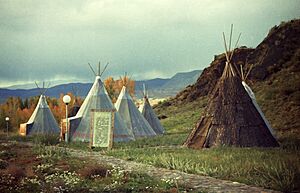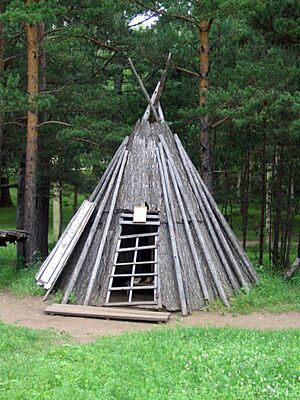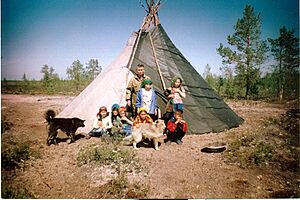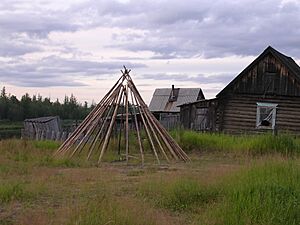Chum (tent) facts for kids

A chum is a special kind of portable tent. It serves as a traditional home for many nomadic groups. These groups live in parts of northwestern Siberia, Russia, and northern Mongolia. People like the Nenets, Khanty, Evenks, and Ket people use chums. They are perfect for families who travel with their reindeer herds. The chum looks similar to a Native American tipi. It is also related to the Sami lavvu, but often larger. Some chums can be up to ten meters (about thirty feet) wide!

Contents
Building a Chum: Materials and Design
The main structure of a traditional chum is made from wooden poles. These poles are carefully arranged in a circle. They lean together at the top, forming a strong cone shape. The cover for this frame is very important. It can be made from reindeer hides sewn together. People also use natural materials like bark or felt. Today, some chums even use modern, durable fabrics.
Inside the chum, a fireplace sits in the center. This fire provides warmth during cold weather. It also helps to keep away pesky insects like mosquitoes. Smoke from the fire rises and escapes through a special opening at the top of the chum.
Life Inside a Chum
Even though the wooden frame and cover can be quite heavy, they are designed to be portable. Reindeer are often used to carry the chum's parts when families move. This makes the chum a very practical shelter. It protects its inhabitants from harsh weather conditions. It allows them to follow their reindeer herds across vast landscapes.
Chums Today: A Living Tradition
The chum is not just a dwelling from the past. It is still a vital part of life for many communities today. The Yamal-Nenets, Khanty, and Todzha Tyvan people in Russia continue to use chums. They live in these traditional homes all year round. This shows how effective and important the chum design remains for their culture.
The Name "Chum"
The word "chum" (Russian: чум) comes from the Russian language. It originally came from words like Komi (Komi-Zyrian: ćom) and Udmurt (Udmurt: ćum). Both of these words mean "tent" or "shelter." In different languages, this type of dwelling has other names. For example, the Nenets call it "ḿāʔ" and the Evenks call it "ǯū."
See also



